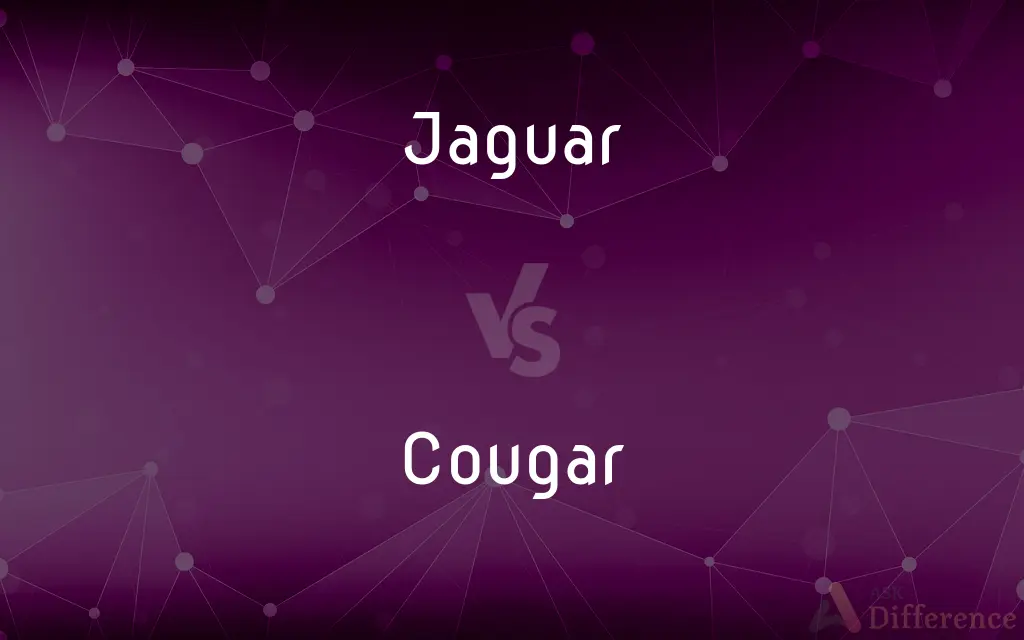Jaguar vs. Cougar — What's the Difference?
By Fiza Rafique & Maham Liaqat — Updated on April 8, 2024
Jaguars are large, powerful felines known for their spotted coats, prevalent in South and Central America, while cougars are more uniform in color, found in North and South America.

Difference Between Jaguar and Cougar
Table of Contents
ADVERTISEMENT
Key Differences
Jaguars are renowned for their strength and powerful jaws, capable of breaking through turtle shells and caiman scales, making them formidable predators in their habitats. They are associated with water and often hunt by ambushing prey near rivers or lakes. Cougars, on the other hand, have a more adaptable approach to hunting and can thrive in various environments, from forests and mountains to deserts.
Jaguars have a distinctive spotted coat, which helps them camouflage in the dense forests and grasslands they inhabit. This pattern is not just for show; it plays a crucial role in their hunting strategy, allowing them to blend into the environment and stalk prey with stealth. Unlike jaguars, cougars do not have a preference for water and are less dependent on aquatic habitats for hunting. Their coat is of a uniform color, ranging from tan to grayish, which helps them blend into a wider variety of landscapes.
Jaguars are typically larger and more robust than cougars, with males weighing up to 250 pounds, whereas male cougars can weigh up to 220 pounds. This size difference reflects in their prey choice and hunting techniques, with jaguars often taking down larger prey such as deer, capybaras, and even caimans. Cougars, while also powerful, rely more on their agility and speed over brute strength. Their hunting method usually involves stalking their prey to get as close as possible before launching a quick and powerful attack, aiming for the neck to suffocate their prey.
Jaguars' physical attributes, particularly their jaw strength, allow them to employ a unique killing method - penetrating the skulls or neck vertebrae of their prey with a single bite.
Cougars primarily feed on deer but can hunt species as small as insects and as large as elk, demonstrating their versatility as predators.
ADVERTISEMENT
Both jaguars and cougars are solitary animals, with territories marked by scent markings. However, their social behavior has subtle differences. Jaguars are more water-oriented, often found near rivers and lakes, which influences their territorial boundaries. Cougars, however, are known for their vast territories that can encompass both forests and mountains, reflecting their adaptability to different environments. Their social interactions are primarily driven by the need to mate and defend their territories from rivals.
Comparison Chart
Habitat
Prefers dense forest, wetlands, and river areas.
Adaptable to a wide range of habitats, including forests, mountains, and deserts.
Appearance
Spotted coat, larger and more robust body.
Uniform color coat, slightly smaller and more slender.
Hunting and Diet
Ambush predator, prefers larger prey near water.
Stalks a wide variety of prey, from insects to large mammals.
Geographic Range
South and Central America.
North and South America, from Canada to the Andes.
Social Behavior
Solitary, territories often include water bodies.
Solitary, with large territories that can vary widely in terrain.
Compare with Definitions
Jaguar
A large, carnivorous cat native to the Americas, known for its powerful build and spotted coat.
The jaguar stealthily navigated the Amazonian underbrush, unseen by its prey.
Cougar
A large, solitary cat known for its tan to grayish coat, lacking the spots of a jaguar.
The cougar roamed the rocky mountain terrain, searching for its next meal.
Jaguar
The third-largest feline after the tiger and lion, with a bite force capable of piercing turtle shells.
Observers marvel at the jaguar's bite, strong enough to crack open hard-shelled river creatures.
Cougar
An adaptable predator, found in a variety of North and South American habitats.
Cougars adapt their hunting techniques to succeed in diverse environments, from deserts to forests.
Jaguar
An apex predator in its habitat, playing a crucial role in controlling other populations.
Jaguars keep the population of capybaras in check, preventing overgrazing in their habitat.
Cougar
Prefers to stalk and ambush its prey, often attacking from behind.
The cougar's silent approach allowed it to get close to the deer unnoticed.
Jaguar
Known for its swimming ability, often hunting fish or caiman.
The jaguar plunged into the river, swiftly catching a fish with its jaws.
Cougar
Holds cultural significance in many native traditions, symbolizing cunning and strength.
Native stories often depict the cougar as a wise and formidable hunter.
Jaguar
Symbolizes power and agility in various cultures, often featured in mythology and folklore.
In Mayan culture, the jaguar was revered as a symbol of might and stealth.
Cougar
Known for their incredible leaping and sprinting abilities, essential for catching prey.
With a powerful leap, the cougar overcame the steep incline with ease.
Jaguar
The jaguar (Panthera onca) is a large felid species and the only living member of the genus Panthera native to the Americas. Its distinctively marked coat features pale yellow to tan colored fur covered by spots that transition to rosettes on the sides.
Cougar
The cougar (Puma concolor) is a large cat of the subfamily Felinae. Native to the Americas, its range spans from the Canadian Yukon to the southern Andes in South America and is the most widespread of any large wild terrestrial mammal in the Western Hemisphere.
Jaguar
A large feline mammal (Panthera onca) of Mexico, Central America, and South America, closely related to the leopard and having a tawny coat spotted with black rosettes.
Cougar
A large powerful wild cat (Puma concolor syn. Felis concolor) chiefly of mountainous regions of the Americas, having an unmarked tawny body and a long tail. Also called catamount, mountain cat, mountain lion, panther, puma; Also called regionally painter.
Jaguar
A carnivorous spotted large cat native to South and Central America, Panthera onca.
Cougar
(Slang) A woman, especially one over 30, who romantically pursues or attracts younger men.
Jaguar
A large and powerful feline animal (Panthera onca, formerly Felis onca), ranging from Texas and Mexico to Patagonia. It is usually brownish yellow, with large, dark, somewhat angular rings, each generally inclosing one or two dark spots. It is chiefly arboreal in its habits. It is also called the panther and the American tiger.
Cougar
Puma concolor, a wild feline native to the Americas.
Florida panther
Jaguar
A large spotted feline of tropical America similar to the leopard; in some classifications considered a member of the genus Felis
Cougar
An American feline quadruped (Felis concolor), resembling the African panther in size and habits. Its color is tawny, without spots; hence writers often called it the American lion. Called also puma, panther, mountain lion, and catamount. See Puma.
Cougar
Large American feline resembling a lion
Common Curiosities
What type of prey do jaguars prefer?
Jaguars prefer larger prey such as deer, capybaras, and even caimans.
Can cougars live in desert environments?
Yes, cougars can adapt to live in deserts as well as forests and mountains.
Do both jaguars and cougars have spots?
Jaguars have a spotted coat, while cougars have a uniform color coat.
How do jaguars kill their prey?
Jaguars kill their prey by piercing the skull or neck vertebrae with their powerful jaws.
How does a cougar's hunting strategy differ from a jaguar's?
Cougars stalk and ambush a wide range of prey, relying on stealth and speed, whereas jaguars often ambush prey near water bodies using their strength.
Are jaguars or cougars bigger?
Jaguars are generally larger and more robust than cougars.
What is the geographic range of the cougar?
Cougars have a broad range, from Canada to the Andes in South America.
How do cougars communicate?
Cougars communicate through visual and olfactory signals, as well as vocalizations such as growls and whistles.
What is the primary habitat of a jaguar?
Jaguars prefer dense forests, wetlands, and areas near rivers.
Are jaguars good swimmers?
Yes, jaguars are excellent swimmers and often hunt in water.
What role do jaguars play in their ecosystem?
Jaguars are apex predators, controlling the populations of other species and maintaining ecological balance.
Share Your Discovery

Previous Comparison
Harikari vs. Seppuku
Next Comparison
Umbilicus vs. NavelAuthor Spotlight
Written by
Fiza RafiqueFiza Rafique is a skilled content writer at AskDifference.com, where she meticulously refines and enhances written pieces. Drawing from her vast editorial expertise, Fiza ensures clarity, accuracy, and precision in every article. Passionate about language, she continually seeks to elevate the quality of content for readers worldwide.
Co-written by
Maham Liaqat













































